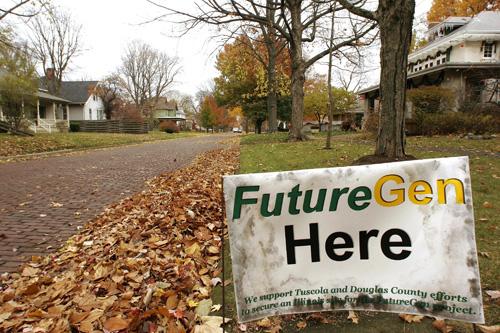FutureGen site to be announced

December 3, 2007
The location of a near-zero emissions power plant is scheduled to be announced later this month.
Southern Illinois cities Mattoon and Tuscola are still in the running against Texas cities Odessa and Jewett to become the site of the FutureGen power plant that will use an alternative method to process coal and generate electricity.
The plant is part of a 2003 initiative by President Bush that aims to decrease the environmental harm of coal-powered energy production.
Supported by the FutureGen Alliance, a nonprofit industrial consortium of some of the largest coal producers and users in the world, and the U.S. Department of Energy, the plant is to be the first of its kind.
“It’s going to be the world’s first sequestration and hydrogen production research power plant,” said John Grasser, director of communications for the Fossil Energy Program – part of the U.S. Department of Energy. “When it’s up and operating, it’s going to be the cleanest (fossil-fuel fired) power plant in the world.”
Get The Daily Illini in your inbox!
“The final Environmental Impact Statement has been issued by the (Environmental Protection Agency),” Grasser said. “The FutureGen Alliance will make the announcement of the location of the site in December.”
FutureGen for Illinois, an organization that has played a large role in the local effort, held a pep rally Dec. 2 to show the state’s support for the FutureGen power plant.
Wyoming became the latest state to join Indiana, Kentucky, Ohio, Pennsylvania and Wisconsin in backing Illinois’ bid for the plant.
“It is exciting to see the support that the states are giving to the process,” said Lawrence Pacheco, spokesman for FutureGen Alliance. “People have been very receptive.”
The power plant will be built and operated by the FutureGen Alliance, Pacheco added.
The alliance began the process of choosing the site in 2006, weeding through 12 prospective candidate sites before narrowing to the final four.
“There are many different criteria for choosing the site such as rock formations for the carbon capture and storage process.” Pacheco said. “In the end, the decision where the plant will be placed will be based on the science, the risk and the benefits and the economic impact of building at a particular site.”
The power plant will take coal and, through a variety of complex systems, gasify it. Coal gasification, referred to in the industry as IGCC, is a technology that already exists. There is no facility in the world that combines both carbon capture and IGCC, Pacheco said.
“You come up with hydrogen and carbon dioxide,” Grasser said. “You separate the gasses and it will pump the carbon underground where it will stay. One of the advantages to gasification is you lose a lot of the impurities of coal. You remove the chemicals up front.”
With about 70 percent of their power plants using coal to generate energy, American Electric Power, a company in the FutureGen Alliance, has a stake in this new power plant’s success.
“We think it’s important to further the technology that can use coal for energy with less of an environmental impact,” said Melissa McHenry, spokesperson for American Electric Power. “It will benefit (American Electric Power) and a number of power plants that use coal.”
The total cost of the plant is estimated to be $1.5 billion when the anticipated offset revenue gained from energy made at the plant is included, Grasser said.
“The federal government is putting up 76 percent of the $1.5 billion and 24 percent is coming from the private sector of the FutureGen Industrial Alliance,” Grasser said.
The power plant will be of smaller size, generating 275 megawatts of electricity to power about 150,000 U.S. commercial homes, according to the FutureGen Web site. It will also have a higher efficiency than the average coal power plant.
“The technology is different,” Grasser said. “If you compare it to other plants it’s going to use a little less (coal), mostly because of its efficiency. Other plants just pulverize the coal and burn it.”






